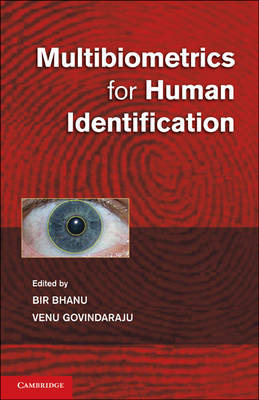
Multibiometrics for Human Identification
Cambridge University Press (Verlag)
978-0-521-11596-4 (ISBN)
In today's security-conscious society, real-world applications for authentication or identification require a highly accurate system for recognizing individual humans. The required level of performance cannot be achieved through the use of a single biometric such as face, fingerprint, ear, iris, palm, gait or speech. Fusing multiple biometrics enables the indexing of large databases, more robust performance and enhanced coverage of populations. Multiple biometrics are also naturally more robust against attacks than single biometrics. This book addresses a broad spectrum of research issues on multibiometrics for human identification, ranging from sensing modes and modalities to fusion of biometric samples and combination of algorithms. It covers publicly available multibiometrics databases, theoretical and empirical studies on sensor fusion techniques in the context of biometrics authentication, identification and performance evaluation and prediction.
Dr Bir Bhanu is the Distinguished Professor of Electrical Engineering and serves as the Director of the Interdisciplinary Center for Research in Intelligent Systems and the Visualization and Intelligent Systems Laboratory at the University of California, Riverside (UCR). He is a coauthor of seven authored books and three edited books, has 12 patents, and has authored more than 350 reviewed technical publications, including more than 100 journal papers. Dr Venu Govindaraju is a UB Distinguished Professor of Computer Science and Engineering at the University at Buffalo (SUNY Buffalo) and the founder of the Center for Unified Biometrics and Sensors (CUBS). He has coauthored more than 300 reviewed technical papers, four U.S. patents and two books.
Part I. Multimodal and Multisensor Biometric Systems: 1. Multi-modal ear and face modeling and recognition Steven Cadavid, Mohammad H. Mahoor and Mohamed Abdel-Mottaleb; 2. Audio-visual speech synchrony detection by a family of bimodal linear prediction models Kshitiz Kumar, Gerasimos Potamianos, Jiri Navratil, Etienne Marcheret and Vit Libal; 3. Multi-spectral contact-free palmprint recognition Ying Hao, Zhenan Sun and Tieniu Tan; 4. Face recognition under the skin Pradeep Buddharaju and Ioannis Pavlidis; Part II. Fusion Methods in Multibiometric Systems: 5. Biometric authentication: a copula based approach Satish G. Iyengar, Pramod K. Varshney and Thyagaraju Damarla; 6. An investigation into feature level fusion of face and fingerprint biometrics Ajita Rattani and Massimo Tistarelli; 7. Adaptive multibiometric systems Luca Didaci, Gian Luca Marcialis and Fabio Roli; Part III. Hybrid Biometric Systems: 8. Multiple projector camera system for three-dimensional gait recognition Koichiro Yamauchi, Bir Bhanu and Hideo Saito; 9. Gait recognition using motion physics in a neuromorphic computing framework Ricky J. Sethi, Amit K. Roy-Chowdhury and Ashok Veeraraghavan; 10. Face tracking and recognition in a camera network Ming Du, Aswin Sankaranarayanan and Rama Chellappa; 11. Bi-directional relighting for 3D aided 2D face recognition G. Toderici, G. Passalis, T. Theoharis and I. A. Kakadiaris; Part IV. Databases and Security: 12. On acquisition and analysis of a dataset comprising of gait, ear and semantic data Sina Samangooei, John D. Bustard, Richard D. Seeley, Mark S. Nixon and John N. Carter; 13. Dynamic security management in multi-biometrics Ajay Kumar; Part V. Performance of Multibiometric Systems: 14. Prediction for fusion of biometrics systems Rong Wang and Bir Bhanu; 15. Predicting performance in large-scale identification systems by score re-sampling Sergey Tulyakov and Venu Govindaraju.
| Zusatzinfo | 40 Tables, unspecified; 18 Plates, unspecified; 55 Halftones, unspecified; 89 Line drawings, unspecified |
|---|---|
| Verlagsort | Cambridge |
| Sprache | englisch |
| Maße | 162 x 235 mm |
| Gewicht | 680 g |
| Themenwelt | Informatik ► Grafik / Design ► Digitale Bildverarbeitung |
| Informatik ► Theorie / Studium ► Künstliche Intelligenz / Robotik | |
| ISBN-10 | 0-521-11596-5 / 0521115965 |
| ISBN-13 | 978-0-521-11596-4 / 9780521115964 |
| Zustand | Neuware |
| Haben Sie eine Frage zum Produkt? |
aus dem Bereich


